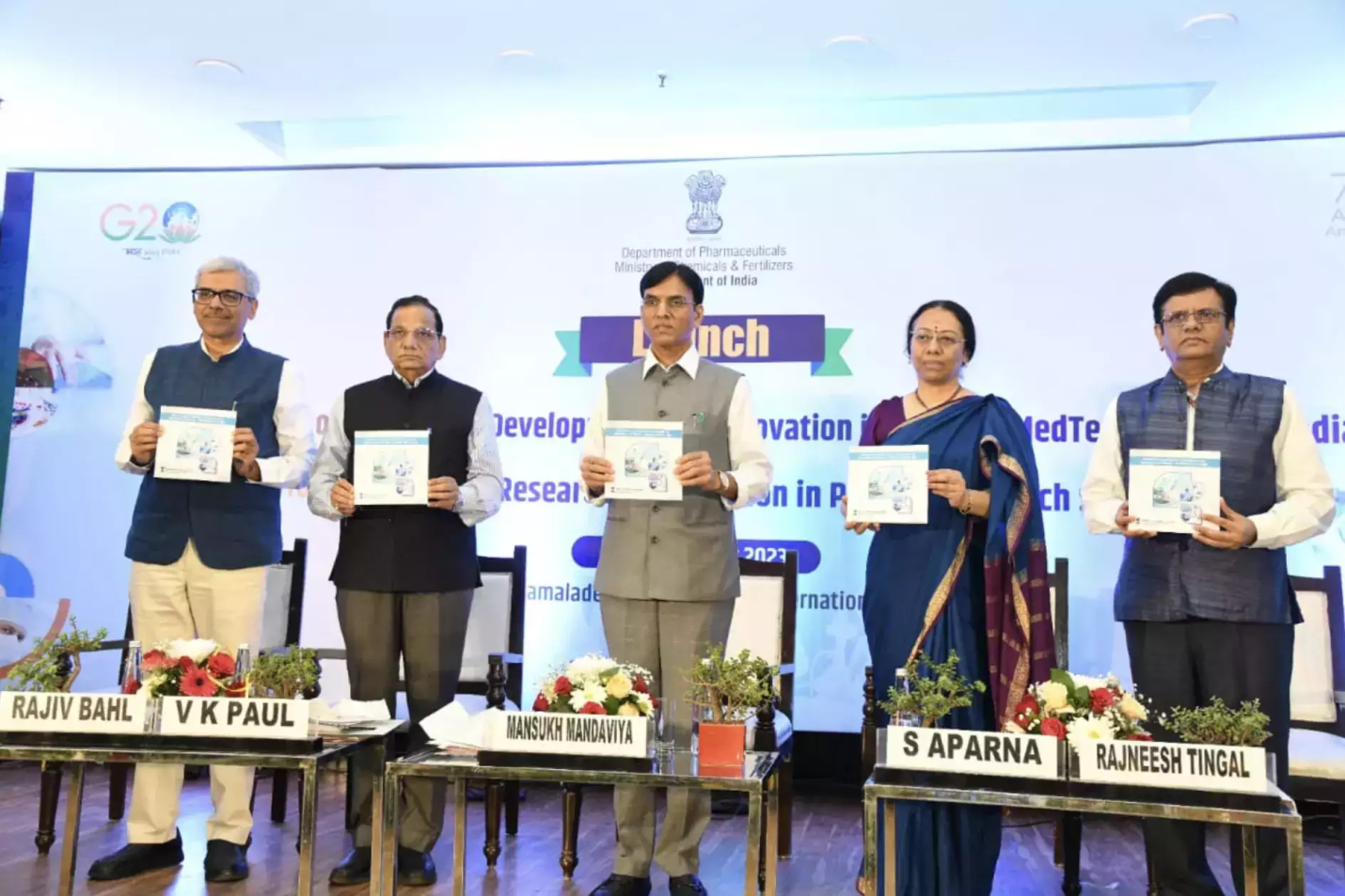Description

Copyright infringement not intended
Picture Courtesy: economictimes
Context: The launch of the National Policy on Research and Development and Innovation in the Pharma-MedTech Sector in India and the PRIP scheme by the Union Minister of Chemicals and Fertilizers signifies a crucial move towards bolstering self-reliance and innovation in India's pharmaceutical and medical technology sectors.
National Policy on Research and Development and Innovation in the Pharma MedTech Sector
- The National Policy on Research and Development and Innovation in the Pharma MedTech Sector in India is a comprehensive framework designed to promote and facilitate research, innovation, and development in the pharmaceutical and medical technology sectors in the country.
Key points about this policy
- Department of Pharmaceuticals' Role: The Department of Pharmaceuticals is responsible for promoting and coordinating various aspects related to the pharmaceutical sector, including research, education, and international cooperation. This includes the oversight of the National Institutes of Pharmaceutical Education and Research (NIPERs).
- Growth Potential of the Pharmaceutical Industry: The policy acknowledges the substantial growth potential of the Indian pharmaceutical industry, which is currently the third-largest in the world by volume, with a market size of approximately USD 50 billion. The industry is projected to expand to USD 120-130 billion over the next decade, driven in large part by a focus on innovation.
- High-Level Inter-Departmental Committee: In response to recommendations from the Parliamentary Standing Committee, the Department of Pharmaceuticals established a high-level inter-departmental committee. This committee was tasked with drafting and finalizing a policy on research, development, and innovation in the pharmaceutical and medical devices sectors. The committee included representatives from various ministries, departments, and industry leaders.
- Policy Objectives: The policy aims to encourage research and development in pharmaceuticals and medical devices and create an ecosystem conducive to innovation. Its main objectives are:
- Creating a Regulatory Environment for Innovation: The policy seeks to establish a regulatory environment that fosters innovation and research in product development, going beyond traditional safety and quality considerations.
- Incentivizing Investment in Innovation: It aims to incentivize both private and public sector investments in innovation through a combination of fiscal and non-fiscal measures.
- Building an Enabling Ecosystem: The policy envisions building a supportive ecosystem for innovation and cross-sectoral research as a strong institutional foundation for sustainable growth in these sectors.
- Indian Council of Pharmaceuticals and Med-tech Research and Development: The policy proposes the establishment of an Indian Council of Pharmaceuticals and Med-tech Research and Development. This council is intended to facilitate and promote collaboration among industry, academia, and research institutions across different departments. It aims to foster domestic and international collaboration in R&D in the pharmaceutical and medtech sectors.

Expected Impact
- The policy outlines several expected outcomes, including a higher contribution to India's GDP, increased exports and forex inflow, a larger global market share, enhanced drug security and availability, improvements in the overall healthcare index, reduced disease burden, the creation of high-end jobs in R&D and innovation, and the opportunity to attract Indian talent with expertise in these fields back to the country.
About PRIP (Promotion of Research and Innovation in Pharma MedTech Sector)
- The PRIP (Promotion of Research and Innovation in Pharma MedTech Sector) scheme is a significant initiative aimed at promoting research and innovation in the pharmaceutical and medical technology sectors in India.
- The primary objective of PRIP is to shift the Indian pharmaceutical sector from a cost-based model to an innovation-based one by strengthening the research infrastructure within the country.
- The scheme seeks to encourage industry-academia collaboration in research and development in priority areas, fostering a culture of high-quality research and nurturing a pool of talented scientists. This is expected to enhance India's global competitiveness and contribute to employment generation.
Key points about the scheme
- Indian Pharmaceutical Industry Growth: The scheme recognizes the potential for substantial growth in the Indian pharmaceutical industry, projecting it to reach USD 120-130 billion over the next decade. One of the driving forces for this growth is the expansion of the industry's presence in the innovation space.
- Addressing Import Dependence: The scheme acknowledges the current import dependence on patented drugs and aims to incentivize both global and domestic players to invest in high-value production, including biopharmaceuticals, complex generic drugs, patented drugs, and more. This approach aims to reduce India's reliance on imported patented drugs.
- Government's Commitment: The Government of India has demonstrated its commitment to fostering pharmaceutical innovation by announcing the scheme in the budget for 2023-24. This indicates the government's recognition of the need to promote research and development in the pharmaceutical and medtech sectors.
PRIP consists of two main components
- Component A: This component focuses on strengthening research infrastructure through the establishment of seven Centers of Excellence (CoEs) at the National Institute of Pharmaceutical Education and Research (NIPER) institutions. A financial outlay of Rs. 700 crores has been allocated for this component.
- Component B: This component is geared towards promoting research in the pharmaceutical sector, with an emphasis on six priority areas, including New Chemical Entities, Complex generics (including biosimilars), medical devices, stem cell therapy, orphan drugs, and addressing anti-microbial resistance. Financial assistance will be provided to industries, MSMEs, SMEs, startups collaborating with government institutes, and for both in-house and academic research. Component B has a financial outlay of Rs. 4,250 crores.
Significance
- Development of Research Infrastructure: Investing in research infrastructure at institutions like NIPERs can significantly enhance the research capabilities of these institutions. This can lead to advancements in pharmaceutical science and technology, fostering innovation and discovery.
- Promotion of Industry-Academia Linkages: Collaboration between the private sector and government institutes can result in a synergy of resources, knowledge, and expertise. This partnership can lead to the development of innovative pharmaceutical products and technologies that benefit both sectors.
- Focus on Priority Areas: By prioritizing specific areas, the scheme can strategically allocate resources and efforts to address critical needs in the pharmaceutical industry. This targeted approach can position India as a leader in these areas on the global stage.
- Launch of Commercially Viable Products: The scheme's emphasis on launching commercially viable products can have a positive impact on the growth of the Indian pharmaceutical sector. Successful product launches can increase revenue and profitability, which, in turn, can create more employment opportunities within the industry.
- Development of Affordable Solutions: The development of affordable and accessible healthcare solutions can contribute to reducing the healthcare burden on the population. This can improve overall public health and make essential healthcare services more accessible to a broader segment of the population.
.jpg)
Conclusion
- Overall, these initiatives are aimed at making India a global leader in pharmaceuticals and medical technology by fostering innovation, research, and collaboration among various stakeholders in these sectors.
Must Read Articles:
MEDICAL DEVICE INDUSTRY: https://www.iasgyan.in/rstv/medical-device-industry#:~:text=In%20the%20Union%20Budget%202022,devices%20in%20the%20global%20market.
National Medical Devices Policy: https://www.iasgyan.in/daily-current-affairs/national-medical-devices-policy
|
PRACTICE QUESTION
Q. What are the key objectives and components of the National Policy on Research and Development and Innovation in the Pharma MedTech Sector in India, and how does it aim to contribute to the growth and self-reliance of India's pharmaceutical and medical technology industries?
|










